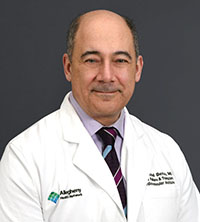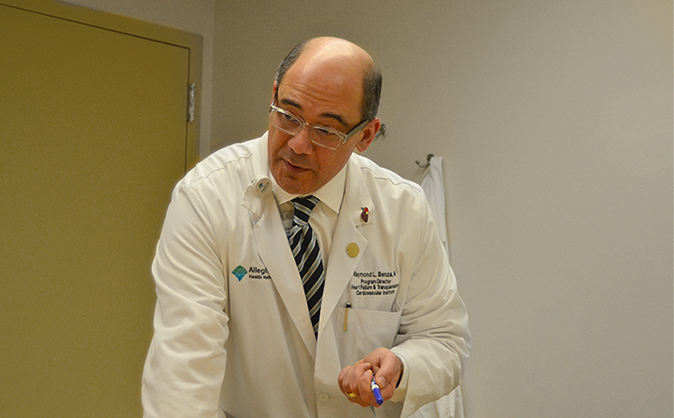Raymond Benza, MD comes from a long line of cobblers and barbers. So it’s a remarkable life’s journey to where he is now: medical director for Advanced Heart Failure, Transplantation, Mechanical Circulatory Support, and Pulmonary Hypertension at AHN Cardiovascular Institute. Internationally renowned researcher, including a NIH-funded study of what is expected to become the most commonly used risk prognostic tool for patients with pulmonary arterial hypertension. Elected board member of The International Society of Heart and Lung Transplantation.

Dr. Ray Benza, internationally renowned clinician and research scientist in heart failure, cardiac transplantation, mechanical circulatory support, and pulmonary hypertension at the AHN Cardiovascular Institute.
And, along the way, also a mountain climber who scaled Africa’s tallest peak and received knighthood under the Royal House of Savoy for his public service efforts.
I interviewed Dr. Benza initially to write an article about pulmonary hypertension. Now, read on to learn more about his background, thoughts on the evolution of cardiology and coordinated care at Allegheny Health Network (AHN), and good work inside and outside the hospital and research lab.
Dr. Benza grew up in the Bronx, New York City. His father was the first in the family to get a college education after crossing the ocean from Italy. Other immediate relatives went on to become attorneys and judges, but Dr. Benza says his path was clear early on.
“I didn’t like politics, but I loved the sciences,” he explains. “In kindergarten, my mother got me a stethoscope and I was hooked. Of course, I later realized that medicine is a political landscape, too.”
He graduated from the University of Florida College of Medicine, did his residency at University of Michigan Hospitals and Health Center, and then did a fellowship in cardiology at the University of Alabama at Birmingham. At points, it was a hard climb.
“Medical school was a challenging time in my life,” he says. “I encountered many roadblocks. But since then I’ve realized that roadblocks may be the best thing that can happen to a person. They make you better.”
His residency in Ann Arbor, Michigan helped him discover his passion for cutting-edge medicine — which he defines as medicine that takes place on the fine line between life and death. He was then accepted into an interventional cardiology fellowship for angioplasty — the unblocking and repair of coronary arteries and veins. But his division chief approached him with another specialization in mind: heart failure and transplantation. Recognizing Dr. Benza’s interpersonal skills and motivations, the reasoning was that this field would not only give him the opportunity to practice life-saving medicine, but also develop meaningful, lasting bonds with patients and their families.
“When you go into medicine, you have to make sure you follow the right road, look for the right signals,” Dr. Benza says. “I listened to that advice and I don’t regret it. In heart failure and transplantation, you see these people for the rest of their lives. It’s like having a second family.”

Dr. Benza emphasizes that helping heart patients is not a solo climb — it requires coordinated care and excellent communication across a multidisciplinary team.
In 2008, Dr. Benza arrived in Pittsburgh to help build on a rich legacy of innovative cardiology at Allegheny General Hospital (AGH) that goes back to Dr. George Magovern, Sr. In addition to inventing numerous devices that revolutionized heart surgery, Dr. Magovern performed the world’s second lung transplant, Pennsylvania’s first aortic valve replacement surgery in 1961, and its second heart transplant in 1969.
During Dr. Benza’s tenure, the prestigious heart transplant program at AGH has continued evolving and became part of the highly regarded, top-ranked AHN Cardiovascular Institute. In the course of his career, Dr. Benza has seen — and contributed to — amazing advances in the field of cardiology.
“The difference between when I started in the 1990s and now is night and day,” he says. “Treatment for end-stage heart disease is especially inspiring. The advances we’ve made have afforded some people an extra 10 or even 20 years of life.”
However, he also points out that better care cannot come from technology alone — and that too much focus on technology can have potentially negative consequences.
“I think there needs to be a control, a balance, on the technology explosion,” he says. “As technology advances, so does the cost that’s being incurred on society, so we need to use it in ways that are both helpful and cost-effective.”
Regardless of new leaps in technology or pharmaceutical options, he also believes that it is critically important to stay focused on the relationship between doctor and patient.
“The magic of medicine,” he says, “is not only what we can do with our knowledge, but how we can heal with the power of touch and communication. Medicine is not just an intellectual game, and your patient is not just a name on a list. Medicine is about the empathy you feel for your patients, and your ability to put yourself in their shoes.”
As recounted in our previous article, that focus on close doctor-patient bonds, and a desire to better understand what his patients were going through, led to Dr. Benza’s mountaineering ventures:
I was sitting with a patient of mine, who was dying of pulmonary hypertension. She was listed for transplant but was getting too sick to be a candidate. She saw that I was distraught, and I remember she sat me down and reached out and held my hand — which is quite a difference because it usually goes the other way around.
She said, “Listen, there’s nothing for you to feel guilty about. You have to remember you can’t always move mountains.”
When she said that, everything clicked. I thought, “Well, I can’t move the mountain, but if it will make a difference, I’m going to climb it.”
In 2007, he climbed the Grand Tetons — an experience he calls “more than I bargained for.” One misstep left him upside down, hanging by a rope, looking into an enormous crevasse. In that moment, he says he realized more fully the helplessness his patients must feel. His guide was able to hold him steady so he could climb back up. That allowed him to reach the summit, do a dedication to his patient at the top, and go on to an even more challenging climb: Mt. Kilimanjaro.
“It took seven days to summit Mt. Kilimanjaro,” he says, adding that the hike wound through ever-changing landscapes: tropical forest, high desert, and terrain he compared to the surface of the moon.
“You have to keep your mind off the cold, so you wind up just staring at the person’s shoes in front of you, sort of hypnotized, trying to keep the pace,” he says. “I remember as we were getting close to the summit, I could see a littering of people on either side of the mountain, just too tired to make it. At some point, I tripped and fell. I didn’t realize how tired I must have been because I couldn’t get back up. But a guide came over and put his hand on my shoulder. He said, ‘You’re going to make this.’ He picked me up and pushed me forward. He made sure I finished.”
Dr. Benza and his team raised $150,000 for pulmonary hypertension research during that climb. He also raised his own awareness of the breathlessness his pulmonary hypertension patients feel.
When the average person runs, they get breathless, but it goes away instantly when they stop. On the mountain, at very high altitudes, breathlessness never goes away — just as it doesn’t go away for someone with pulmonary hypertension. It’s a terrible feeling, not being able to catch your breath. That experience made me appreciate what my patients deal with and made me even more determined to come back and do what I could for them.
With firsthand knowledge of the importance of a good guide, Dr. Benza strives, similarly, to provide a safety line for his patients, an anchor to tether them, a helping hand, and the information and encouragement they need to continue their difficult ascents. But for all that, and despite his many personal accomplishments, he comes back again and again to the people surrounding him and the theme of teamwork.
“Success is dependent on the entire group and not the individual — I’ve been immersed in a group of talented individuals who push each other forward and upward,” he says.
He sees this mindset and the practice of coordinated care as especially vital in cardiology. “We’re not just taking care of the heart,” he says. “We’re taking care of the whole body — the whole person. The things we do affect every part of the body, and so care requires multiple experts working together and having excellent communication.”
As discussed in an earlier article in Highmark Health’s digital magazine, and a feature article in WHIRL, building a coordinated care model, and culture, within the AHN Cardiovascular Institute has been as important to Dr. Benza and his colleagues as any aspect of their work. He believes outcomes are better because the team of experts they’ve assembled are able to function as a “human tricorder.”
“You know how on Star Trek, Dr. McCoy would scan a person with a tricorder and know everything he needed to know? Well, our tricorder is our multidisciplinary approach that connects physicians, superb nurses, pharmacists, social workers and even financial workers who are all sharing information and guiding the patient through their experience,” he explains.
Focusing on collective rather than just individual achievement requires a measure of humility. Dr. Benza embodies this. After his climb of Mt. Kilimanjaro, and the fundraising associated with it, he received an invitation: the Royal House of Savoy in Italy wanted to knight him. The honor, going back hundreds of years, recognizes philanthropic work to help those in need.
“At first,” Dr. Benza says, “I thought my invitation had to be a joke.”
When he was formally knighted in Saint Patrick’s cathedral, he recalls looking to his right and getting another shock: “The person getting knighted next to me was Timothy Dolan, archbishop of New York, a reverend cardinal, a man who could be pope.” He laughs. “I’m sitting there — little Ray Benza — it was a bit intimidating.”